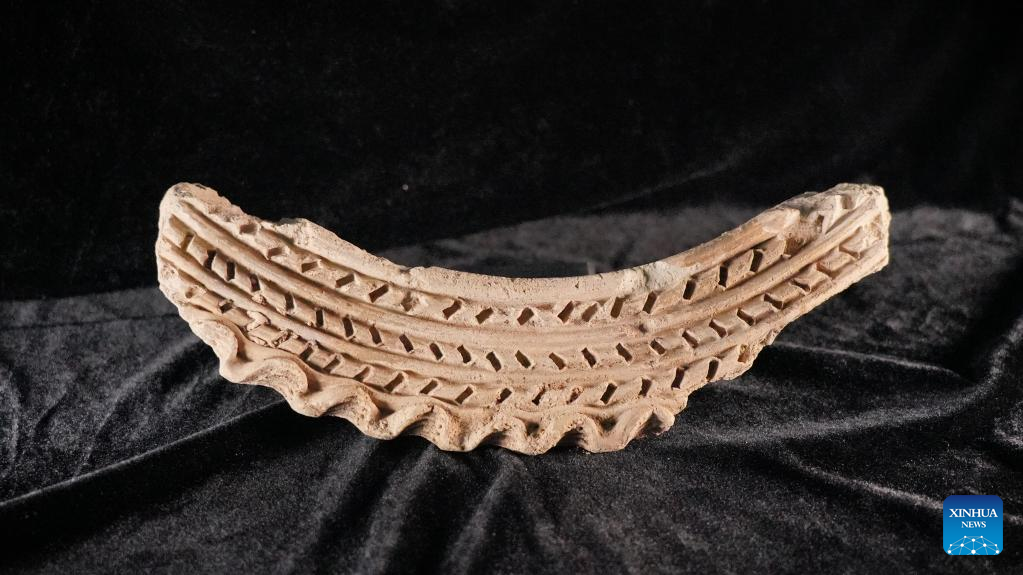Chinese archaeologists find large building ruins in ancient imperial city
Source: Xinhua | 2023-02-24 | Editor:Ines

This photo taken on Dec. 23, 2022 shows a remnant discovered from the south-facing building relics in a courtyard of the imperial city in the ruins of Shangjing, the ancient capital of the Liao Dynasty (907-1125), in Lindong Township of Bairin Left Banner, north China's Inner Mongolia Autonomous region. (Xinhua)
Archaeologists have discovered the ruins of a large building foundation in an imperial city dating back to the Liao Dynasty (907-1125) in north China's Inner Mongolia Autonomous Region.
The building relics were found in late 2022 in a courtyard of the imperial city in the ruins of Shangjing, the ancient capital of the Liao Dynasty, according to the regional institute of cultural relics and archaeology.
The Shangjing site, which was divided into two parts, including an imperial city, is located in Lindong Township of Bairin Left Banner, Inner Mongolia.
An array of artifacts including building components, ceramics, clay sculptures, and copper coins, have also been unearthed.
The nomadic Khitan founded the Liao Dynasty. Archaeologists said the Khitan people believed the east is where the sun rises and can bring auspiciousness and light, so the imperial city and palaces faced east.
The discovery of the large south-facing building has deepened archaeologists' understanding of the layout and history of the ancient Liao capital.
The building is believed to be an important royal establishment in the capital. Historical records show that the imperial city contained key structures such as temples and academies, which can provide some clues to the identity and purpose of the building.

This photo taken on Sept. 27, 2022 shows the south-facing building relics in a courtyard of the imperial city in the ruins of Shangjing, the ancient capital of the Liao Dynasty (907-1125), in Lindong Township of Bairin Left Banner, north China's Inner Mongolia Autonomous region. (Xinhua)
You May Like
-
Horse racing vitalizes ancient village in North China
One day after the Lantern Festival, residents in Xiadongzhai village, North China's Shanxi province, had quick breakfasts before assembling for a long-anticipat...
InKunming 2023-02-09 -
China makes another 6,700 ancient books available online
China made 6,786 sets of ancient books available online on Wednesday, increasing the total number of digitalized ancient resources to 130,000.
InKunming 2023-01-05 -
Great Wall of ancient Qi state gets improved protection
To tackle challenges in protecting the Great Wall of the ancient Qi state, the oldest existing Great Wall in China, the legislature in Shandong province has pas...
InKunming 2022-10-18 -
China issues master plan for ancient books preservation
Chinese authorities have recently issued a master plan for the preservation of ancient books.
InKunming 2022-10-17 -
Relics exhibition reveals metallurgy mysteries along ancient...
A cultural relics exhibition showcasing the development history of metallurgy along the ancient Silk Road has opened in Dunhuang, a renowned Silk Road city in...
InKunming 2022-08-23 -
14 ancient tombs unearthed in central China's Hunan
Archaeologists have found 14 tombs dating back to between the Eastern Han Dynasty (25-220) and the Tang Dynasty (618-907) in central China's Hunan Province.
InKunming 2022-07-11 -
TV drama puts spotlight on ancient tea art
A Dream of Splendor, a 40-episode TV drama streaming on Tencent Video platform, has become a smash hit recently. It narrates a story about a woman running a tea...
InKunming 2022-06-24 -
China to build "gene bank" of ancient ceramics
China will establish a "gene bank" of ancient ceramics in east China's Jiangxi Province, based on data from nearly 20 million pieces of ceramics specimens acc...
InKunming 2022-06-13 -
Three generations of Uygur family devoted to protecting anci...
Gulibekge Maiming Reheman is a conservator of the cultural treasure trove of Jiaohe Ruins, the world's biggest and best-preserved relics of a clay-built city in...
InKunming 2022-05-27 -
Archaeologists identify ancient royal tomb in China's Jiangx...
An ancient tomb in east China's Jiangxi Province has been identified as belonging to the royals of the State of Yue in the Warring States Period (475-221 BC), l...
InKunming 2021-12-27







